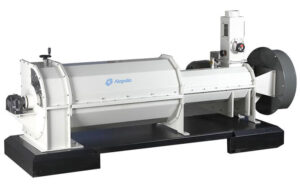
 Author, Title: Alapala Machine
Dampening is an essential part of the wheat milling process. Affecting the flour quality and extraction, an effective dampening operation helps millers achieving better results.
The process of dampening, also referred to as tempering or conditioning, is an important process in grain milling that is used to provide optimum moisture level of the grain before the grinding process.This optimum moisture can be defined as ‘the bran should be hard enough to be separated from the endosperm easily, and the endosperm should be soft enough to be milled properly’.
The process plays an important role on the milling yield and bread-making quality of the flour. It ultimately helps to adjust the flour moisture content as well, which has an important role on profitability.
Impact of the dampening process: How does it work?
The fragile wheat bran tends to crumble during milling, making its separation from the flour harder, ultimately reducing the quality of the flour.The dampening process allows the endosperm to mellow and soften, and the bran to get elasticity so that they can be separated easily from each other.
Author, Title: Alapala Machine
Dampening is an essential part of the wheat milling process. Affecting the flour quality and extraction, an effective dampening operation helps millers achieving better results.
The process of dampening, also referred to as tempering or conditioning, is an important process in grain milling that is used to provide optimum moisture level of the grain before the grinding process.This optimum moisture can be defined as ‘the bran should be hard enough to be separated from the endosperm easily, and the endosperm should be soft enough to be milled properly’.
The process plays an important role on the milling yield and bread-making quality of the flour. It ultimately helps to adjust the flour moisture content as well, which has an important role on profitability.
Impact of the dampening process: How does it work?
The fragile wheat bran tends to crumble during milling, making its separation from the flour harder, ultimately reducing the quality of the flour.The dampening process allows the endosperm to mellow and soften, and the bran to get elasticity so that they can be separated easily from each other.
| Type of Wheat | Ideal Moisture (%) |
| Very Hard | 16.5 - 17.5% |
| Hard | 16.0 – 17 % |
| Semi Hard | 15.5 - 16.0% |
| Soft | 14.5 - 15.0% |
| Chart 1. Ideal moisture before milling | |
| Temperature (Cº) | Dampening Time |
| 21 | 2 -3days |
| 27 | 12 hrs |
| 40 | 8 hrs |
| 60 | 2 hrs |
| 80 | 40 min |
| Chart 2. Relation of temperature and dampening period | |
| Type of Wheat | Dampering Time(hours) |
| Very hard | 36-48 |
| Hard | 24-36 |
| Semi-hard | 18-24 |
| Semi-soft | 12-18 |
| Soft | 6-12 |
| Chart 3. Tempering time for different types of wheat | |
 Intensive Dampening Machine(TCTS)[/caption]
Alapala’s Intensive Dampening Machine(TCTS)is widely and effectively used to increase the moisture level in grains. The inclined helesonic screw it features, the wheat is homogenously mixed with water.The machine offers a high capacity and efficiency in the dampening process.
Compared to inclined models, Alapala’s Horizontal Dampening Machine (TCTI)offers even better efficiency in dampening with more water absorption in shorter periods. The machine consists of two independent sections with different paddle design and rotor diameter. The first section is designed for pre-mixing process, while the intensive mixing and dampening operation is carried out in the following section.
[caption id="attachment_7242" align="alignright" width="251"]
Intensive Dampening Machine(TCTS)[/caption]
Alapala’s Intensive Dampening Machine(TCTS)is widely and effectively used to increase the moisture level in grains. The inclined helesonic screw it features, the wheat is homogenously mixed with water.The machine offers a high capacity and efficiency in the dampening process.
Compared to inclined models, Alapala’s Horizontal Dampening Machine (TCTI)offers even better efficiency in dampening with more water absorption in shorter periods. The machine consists of two independent sections with different paddle design and rotor diameter. The first section is designed for pre-mixing process, while the intensive mixing and dampening operation is carried out in the following section.
[caption id="attachment_7242" align="alignright" width="251"] Horizontal Dampening Machine (TCTI)[/caption]
[caption id="attachment_7243" align="alignleft" width="113"]
Horizontal Dampening Machine (TCTI)[/caption]
[caption id="attachment_7243" align="alignleft" width="113"] Automatic Dampening Machine(TOCA)[/caption]
Complementing the machines mentioned above, Automatic Dampening Machine(TOCA)measures the moisture content, temperature, flow rate, and specific gravity and calculates the required amount of water automatically.It delivers a very high precision with infrared technology.
Source: Email/KSU
Automatic Dampening Machine(TOCA)[/caption]
Complementing the machines mentioned above, Automatic Dampening Machine(TOCA)measures the moisture content, temperature, flow rate, and specific gravity and calculates the required amount of water automatically.It delivers a very high precision with infrared technology.
Source: Email/KSU
Comment Now